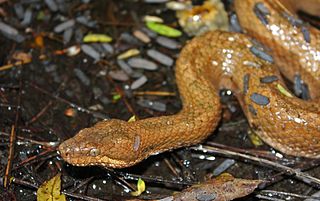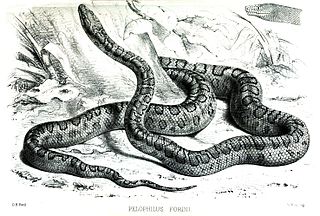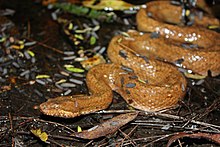
The Tropidophiidae, common name dwarf boas or thunder snakes, are a family of nonvenomous snakes found from Mexico and the West Indies south to southeastern Brazil. These are small to medium-sized fossorial snakes, some with beautiful and striking color patterns. Currently, two living genera, containing 34 species, are recognized. Two other genera were once considered to be tropidophiids but are now known to be more closely related to the boids, and are classified in the subfamily Ungaliophiinae. There are a relatively large number of fossil snakes that have been described as tropidophiids, but which of these are more closely related to Tropidophis and Trachyboa and which are more closely related to Ungaliophis and Exiliboa is unknown.

Tropidophis, common name wood snakes or West Indian wood snakes, is a genus of dwarf boas endemic to the West Indies and South America. Currently, either 17 or 33 species are recognized, depending on the authority.
Tropidophis fuscus is a nonvenomous dwarf boa species found in Cuba. No subspecies are currently recognized.
Tropidophis bucculentus, also known commonly as the Navassa Island dwarf boa, is a nonvenomous dwarf boa species endemic to Navassa Island in the Caribbean Sea. There are no subspecies that are recognized as being valid.
Tropidophis greenwayi is a nonvenomous dwarf boa species endemic to the Caicos Islands. Two subspecies are currently recognized, including the nominate subspecies described here.

Corallus cookii, also known as Cook's tree boa or Cooke's tree boa, is a species of nonvenomous snake in the family Boidae. The species is endemic to the island of St. Vincent in the Caribbean. There are no recognized subspecies.

The Cuban boa, also known as the Cuban tree boa and by locals as maja de Santa María, is a very large species of snake in the family Boidae. With lengths exceeding 5 m (16 ft) and a relatively heavy build, the Cuban boa is one of the largest snakes in the world. The species is native to Cuba and some adjacent islands. No subspecies are recognized.

The Bahamian pygmy boa constrictor, also known as the Inagua trope or Bahama wood snake, is a species of nonvenomous snake in the family Tropidophiidae. The species is endemic to Great Inagua Island in the Bahamas.

Tropidophis feicki, also known commonly as the broad-banded dwarf boa, the broad-banded trope, and Feick's dwarf boa, is a species of non-venomous snake in the family Tropidophiidae. The species is endemic to Cuba.
Tropidophis nigriventis, or the black-bellied dwarf boa, is a species of snake in the family Tropidophiidae. The species is endemic to Cuba.
Tropidophis pilsbryi, commonly known as Pilsbry's dwarf boa or the Cuban white-necked dwarf boa, is a species of snake in the family Tropidophiidae. The species is endemic to Cuba.

Tropidophis taczanowskyi, also known commonly as Taczanowski's dwarf boa, is a species of snake in the family Tropidophiidae. The species is native to northern South America.
Tropidophis wrighti, commonly known as Wright's dwarf boa, the gracile banded dwarf boa, and the gracile banded trope, is a species of snake in the family Tropidophiidae. The species is endemic to Cuba.

Chilabothrus fordii, known commonly as Ford's boa or the Hispaniolan desert boa, is a species of snake in the family Boidae.

Chilabothrus striatus, the Hispaniolan boa, is a species of snake in the family Boidae. The species is endemic to Hispaniola. The species is regularly found in the international pet trade.
The Cayman Brac blind snake is a species of snake in the family Typhlopidae.
Albert Schwartz was an American zoologist who worked extensively with the herpetofauna of Florida and the West Indies, and later with butterflies. One magazine article once dubbed him as one of the "Kings of West Indian Anole Taxonomy".

Uromacer catesbyi, also known commonly as the blunt-headed Hispaniolan vinesnake and Catesby's pointed snake, is a species of snake in the family Colubridae. The species is endemic to the island of Hispaniola.
Caraiba is a monotypic genus of snake in the family Colubridae. The genus contains the sole species Caraiba andreae, also known commonly as the black and white racer or the Cuban lesser racer, which is endemic to Cuba. There are six recognized subspecies.










